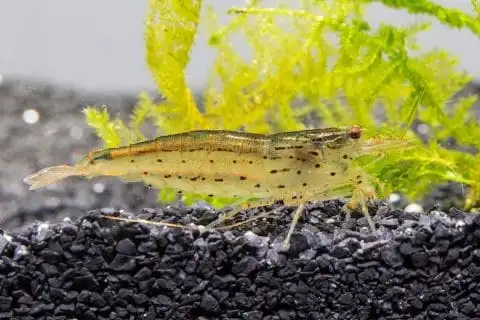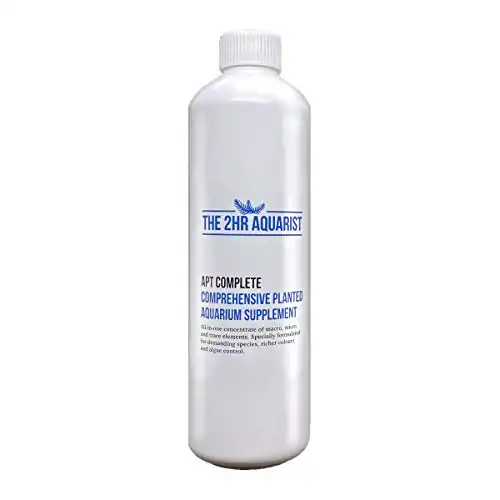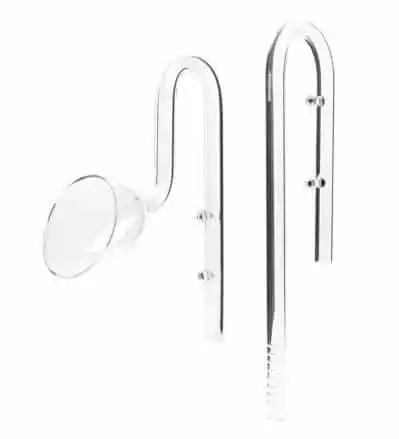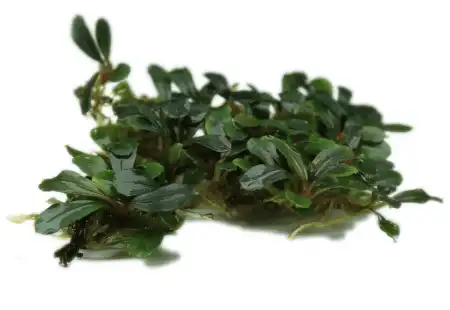Thank you for visiting! By the way… any links on this page that lead to products on Amazon and other stores/partners are affiliate links Aquarium Store Depot earns a commission if you make a purchase.
Are you looking to buy your first Bucephalandra plant? Look no further! This blog post will show you how to find the best one for your needs and care instructions. You’ll learn about what they are, where to get them, what kind of light they need, and much more! We hope this helps make choosing a new plant that much easier.
Species Overview
| Scientific Name | Bucephalandra spp. |
| Common Names | Buce plant, Buceps |
| Family | Araceae |
| Origin | Borneo, Southeast Asia |
| Skill Level | Easy, moderate |
| Lighting | Low, 40 PAR (Umols) |
| Tank Placement | Foreground, Midground |
| Flow Rate | Moderate, High |
| Temperature Range | 71-79°F |
| Height | 1-10 inches |
| pH Range | 6.0 – 8.0 |
| Propagation | Rhizome division |
| Growth Rate | Slow growth rate |
| Feed Type | Column or Root Feeder |
| CO2 Requirement | No, but recommended |
Origins And Habitat
In nature, the Bucephalandra species are mostly found growing densely over stones and aquarium rocks. They grow in and along streams and rivers in tropical forests in Borneo.
In these habitats, the plants are flooded in the rainy season, growing submerged. In the dry season, water levels drop and they continue to grow emersed. Bucephalandra, or buce plants as they are often known, are great low-maintenance plants for beginners or more experienced aquarists. These tough little plants come in a huge range of cultivars, but all are small, slow-growing aquarium plants.
What Do They Look Like?

Bucephalandra species are broadleaf flowering plants that grow from a creeping rhizome that tend to run across rocks and driftwood. Although they are pretty new to the hobby, there are already a huge variety of cultivars and varieties available.
The shape and color of the leaves vary, but the upper sides tend to be glossy, and sometimes even iridescent. The edges of the leaves in the different varieties can be wavy, like as in ‘Wavy Green’ or flattened and leaf shape varies from teardrop-shaped, elongated, to rounded.
The size of the leaves varies a lot as well, depending on the species or variety you have. They measure anything from less than a half an inch long in a type like ‘Black Tears’ to leaves of about 3 inches long in ‘Green Broad Leaf’.
The undersides of the leaves can be spotted in different colors and are often interestingly marked in red, yellow, or white. The tops of leaves can also have interesting white spotting. For many of these species, their new leaves may have strong coloration.
These plants vary in size with some species staying lower than an inch in height, and others reaching over 2 feet. Most plants in the hobby measure between 1 and 10 inches tall.
Placement And Lighting
Being small rhizome plants, buce plants look great when grown rooted in the foreground or on hardscape elements in the midground of the planted aquarium. They are adapted to life in flowing water and this makes them an ideal choice for aquascapes with some current, like hillstream biotopes for example.
Bucephalandra species grow from a creeping rhizome where branches readily emerge them. This new growth will be bigger than the original.
Due to how their new growth and new leaves emerge, they should not be planted in the aquarium substrate. It is possible to grow these aquatic plants rooted, provided only the root system is covered by the gravel.
These plants can be grown attached to aquarium rocks or driftwood and will attach themselves better to surfaces that are heavily textured. Until they are properly attached, they can be secured with thread or glue.
Being a slow-growing broadleaf aquarium plant, the buce plant is vulnerable to algae growth on the leaves, which can happen quickly in a tank with strong planted aquarium lighting and unbalanced parameters. Buce plants are really easy to care for if grown under low light or shaded out by other aquarium plants or hardscape features.
What Are Good Tank Mates?
Bucephalandra plants are suitable for most species only and community freshwater tropical aquariums. These are hardy plants that most fish will not damage or eat.
Good Tank Mates
Good fish species to keep with these aquatic plants include those that enjoy slightly cooler water with a good flow. Hillstream loaches for example may do well with this aquarium plant.
That being said, Bucephalandra is quite an adaptable group and will survive in warmer conditions with a lower flow as well. As a plant with a low growth rate, buceps can easily be overtaken by algae.
Grazers like Otocinclus catfish, Stiphodon gobies, and siamese algae eaters make great tank mates because they will actively clean the surfaces of the leaves. Inverts like Amano shrimp and nerite snails will also help to keep the leaves clean.
Best For Planted Tanks!
When it comes to keeping a healthy planted aquarium, Amano Shrimp are the best. These hard-working crustaceans will dutifully wipe your plants and rockwork clean of algae. Their appetite for different types of algae that can't be matched by other shrimp breeds!
Schooling fish like cherry barbs and cardinal tetra do an excellent job of contrasting the wavy green leaves of the buce plant.
Fish Species To Avoid
Buce plants are pretty tough and hardy specimens in the aquarium. It is probably best to avoid keeping them with large fish like oscars that might disturb them, especially if you plan on growing them rooted.
As a plant that does well in aquariums with a good flow, avoid keeping fish like fancy goldfish or bettas that are not strong swimmers. Buceps are one of the best options for African cichlid and goldfish tanks but this doesn’t mean they’re completely immune to these plant-eaters.
If you do want to grow buceps in a cichlid or goldfish tank, be sure to plant a few plants (the more the better), to spread out the damage and give the plants a chance to recover.
Feeding and Fertilization
How Much And How Often To Feed
Being a slow-growing plant with a low light demand, bucephalandras don’t necessarily need to be fed to maintain good health. Unused nutrients in the water will tend to promote algae growth that the plants may not be able to compete with.
If you wish to grow these plants under more high-tech conditions with stronger lighting and CO2 injection, light feeding in the water column will help these aquatic plants grow faster in these conditions. An all in one aquarium fertilizer like APT Complete is great to use for feeding plants in aquascapes.
Editor's Choice
Made by an aquascaper for aquascapers. This is the best all around aquarium plant fertilizer on the market. Marco and micronutrients in one bottle!
Use Coupon Code ASDComplete for 10% off your order!
If planted in coarse gravel with good water flow to the roots, water column feeding will still provide all the nutrients they need.
Types
There are at least 30 different plant species in the Bucephalandra genus and the taxonomy of plants in the aquarium trade is quite confused. Most buce plant species do not have common names.
There are a huge variety of trade names out there, but the following types are all popular choices:
- Bucephalandra sp. ‘Brownie Ghost’
- Bucephalandra sp. ‘Brownie Brown’
- Bucephalandra sp. ‘Titania’
- Bucephalandra pygmaea ‘Green Wavy’
- Bucephalandra sp. ‘Kedagang’
- Bucephalandra sp. ‘Black Pearl’
- Bucephalandra sp. ‘Green Tears’
- Bucephalandra sp. ‘Super Blue’
- Bucephalandra sp. ‘Deep Blue’
- Bucephalandra sp. ‘Rainbow Marble’
There are a large variety of Buce Plants available. They are best illustrated by a video. This one by iConic Scape is a great slide show of over 20 varieties to see!
Bucephalandra Care Guide
Bucephalandra is similar in its care requirements to the more familiar anubias species. These are not difficult plants to grow, provided you maintain suitable and stable water parameters.
Even under ideal conditions, buce plants are always going to be slow-growing. This makes for a great, low-maintenance option for a planted tank.
Planted Tank Parameters
Bucephalandras are not that particular about water parameters, as long as they are stable. Ideal water temperatures are on the cooler side, but these aquatic plants do well in standard tropical freshwater aquarium temperatures between 71-79°F. If you live in a colder climate, consider purchasing a quality aquarium heater.
If you do run a CO2 system in your tank, begin injection 2 hours before your lights start up and keep your carbon dioxide levels below 30ppm.
Tank size is not very important because these plants don’t get very big and have very slow growth rate. For this reason, bucephalandra plants are great low-maintenance options for nano tanks of about 5 gallons or more, provided you can keep your water parameters stable.
Water Quality
Although bucephalandra plants are considered easy to keep, they do require good water quality. A buce plant grown in an uncycled, or overstocked aquarium with unstable water parameters is likely to melt.
There is loads of information out there on the aquarium nitrogen cycle, but without going into too much detail, a cycled aquarium is one that has an established colony of beneficial bacteria living especially inside the media of its filter.
These good bacteria convert the ammonia in fish waste and uneaten fish food into nitrites and then nitrates which are much safer for plant and animal life. It takes a little while to get a new aquarium cycled, which is why you shouldn’t stock an uncycled aquarium for at least a month or so.
Filtration
Adequate filtration is key to success when growing any bucephalandra species. Good filtration will provide the plants with the flow they prefer as well as assist in maintaining good water quality by maintaining a healthy colony of beneficial bacteria.
Use a filter that creates a good amount of movement in the tank, and processes the volume of your tank at least 4-6 times in an hour. For mass planted tanks, it is best to consider a high end canister filter as plant waste will produce ammonia and added waste matter that a good filter will pick up.
Flow
Bucephalandras are naturally adapted to grow along streams and rivers with a decent amount of flow, particularly in the rainy season. For this reason, it is best to keep them in an environment with a good flow rate to mimic these conditions. The lily pipe is a great way to distribute flow across the aquarium.
A lily pipe is a great way to utiliize high flow canister filters in your aquascape while distributing the flow evenly throughout
Aquarium Maintenance
Testing Water Conditions
Buceps are sensitive to poor water quality and changing water parameters. For this reason, testing water conditions regularly is definitely recommended when growing these aquarium plants.
Pick up some liquid aquarium test kits and start by testing your water before buying the plant. In this way, you can figure out whether your parameters are good.
Record the test results and compare them with your findings the next time you test. By doing this, you’ll be able to figure out how stable your water conditions are.
Retest your water parameters before and after a water change to see how much the conditions are changing and decide whether your water changes are frequent and or large enough. Remember, the smaller your aquarium and the more heavily stocked it is, the more water you’re going to need to change.
How To Set Up Your Aquarium Tank
Buceps grow really well on hardscape elements like aquarium driftwood or lava rock. You can use super glue or fishing wire to attach them.
The best types of super glue for the job are usually the gel types. Another simple trick is to use a rubber band to secure the plant until it has grown roots around the feature.
If you want to grow them rooted, coarse aquarium soil or gravel is recommended. You might want to anchor the plant to the substrate for a few weeks until the roots have had the chance to become established.
Temporarily anchoring the plant will be especially helpful if you have a good water flow in your aquascape. If the conditions in your aquarium are suitable, the roots will grow pretty fast.
How To Propagate
Since bucephalandras grow from a creeping rhizome, the easiest way to propagate new plants is to divide the rhizome. It is important that each portion of the rhizome is large enough, and a good minimum size to aim for is about 1.5 inches.
Health And Disease
Signs Of Health
Even though these plants have a slow growth rate, healthy specimens should produce a new leaf structure or two every few weeks or so. Another sign of a healthy buce plant is flower production. The flowers are pretty short-lived when grown submerged, however.
Signs Of Ill Health
Unhealthy plants will be limp and the leaves will have a light brown coloration. These plants will melt back or become covered in algae.
Common Health Issues And Treatment
Algae growth on the leaves is a common problem in poor water quality because bucephalandra is a slow growth rate plant and their wavy green leaves have large surfaces.
If your plants have lost the fight against algae issues, it is possible to treat them using a product like Seachem Excel or hydrogen peroxide, but remember that some algae in the aquarium is needed if you have algae-eating livestock. Prevention is definitely better than cure though so be sure to figure out the cause and take steps to avoid the algae growing back.
Another common problem with buceps is melt. This often happens just after planting or when moving plants between tanks with different parameters. Melt is less likely to be a problem in tanks with good water flow and added CO2.
Other common causes for melt are unstable water conditions in overstocked, overfed, or uncycled aquariums. Probably the easiest cause of melt to treat is when they are rooted with the rhizome buried. Adjust the position of these plants so that the creeping rhizome is clear of the substrate and prune out any melting growth before it fouls your water.
Plant Pests
The safest way to add a new bucephalandra to your aquascape without introducing any unwelcome pests is to purchase tissue culture specimens. These plants are grown in a sterile, pest-free lab environment.
If you get a potted plant from your local fish store or a cutting from a friend, be sure to inspect the plant carefully for any snails that might be hiding on its leaves. Remove anything you find and also prune out any unhealthy or badly damaged leaves to avoid them melting in your tank.
Dipping your buceps in a very mild bleach solution (20 parts water: 1 part bleach) is another option, just take care not to overdo it and burn your plants. Take care to rinse the plant very well after treatment.
Where To Buy
Although Bucephalanda is a fairly new plant to the hobby, it is quite widely available. You are not going to find them in chain pet stores as a result. They are only going to be available at local fish stores and online. Often the plants you buy at your local fish store have been grown emersed and do not look quite like they will when established underwater, making selecting a specific type or species even more confusing. buying online ensure you get the correct plant variety, and when it comes to online, there is one place I highly recommend.
That would be a store with the very name Buce in it, Buceplant. Their business was founded by a local aquascaping who loves Buce plants so much that he created a store so there could be a reliable source of high quality and less expensive Bucephalandra. If you are shopping online, this is the destination to get these wonderful plants.
Bucephalandra is a slow-growing plant that's perfect for anyone looking to grow their first aquatic plant. They are great for attaching to hardscape
Wherever you end up buying your buceps, make sure you get them from a reputable dealer because the collection and trade of wild buce plant species is a risk to wild populations and their habitat.
FAQS
Are they easy to grow?
The bucephalandra plant species are easy to grow in low-tech aquariums. The best colors and plant growth rate is achieved with stronger light and CO2 injection and this is where more experience is required to limit algae growth on the leaves.
Can they grow on wood?
Bucephalandra is an ideal plant for growing on wood. You will need to attach the rhizome to the wood in some way until the roots have become established enough to keep the aquarium plant anchored.
Where do they grow?
In nature, the Bucephalandra species grow in and along shallow streams and rivers in the tropical jungle environments of Borneo, Southeast Asia.
Does Bucephalandra need substrate?
Bucephalandra does not need substrate and grows well as an epiphyte. These plants can be attached to the hardscape using various methods and will gather their nutrients from the water column.
Why is this so expensive?
The price of bucephalandra plants tends to be pretty high because they are such slow-growing plants, meaning growers can’t produce a lot of plants for the market. Fortunately, authorities have also clamped down on illegal harvesting of wild plants from their natural environment, which is eliminating cheap illegal exports.
Can they grow emersed?
Buce plant species grow well emersed and are great plants for humid ripariums and paludariums as well. Buceps may take slightly different growth forms when grown emersed and they tend to flower better.
Closing Thoughts
As far as low-maintenance aquarium plants go, bucephalandra is pretty hard to beat. They might cost a little more, but these plants offer a great alternative to the similar but more common Anubias nana.
We hope this blog post has helped you learn more about the Bucephalandra plant, and that it’s made your decision to purchase one a little bit easier. If there are any questions we didn’t answer or if something isn’t clear enough for you, please leave us a comment below! Thank you so much for reading our blog – we appreciate your feedback and time!
- About the Author
- Latest Posts
I’m thrilled that you found Aquarium Store Depot! Here you’ll find information on fish, aquariums, and all things aquatics related. I’m a hobbyist (being doing this since I was 11) and here to help other hobbyists thrive with their aquariums! I adhere to a high quality Editorial Process and Review products with real life field usage and practical analysis.









